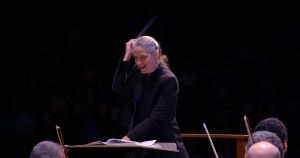Beethoven’s only completed opera, Fidelio, oder Die eheliche Liebe (Fidelio, or Wedded Love), received a glorious concert performance in the Queen City on November 5 (repeated November 6). The work was given on the Charlotte Symphony’s subscription series and involved a magnificently matched and balanced cast of mostly young artists, the Oratorio Singers of Charlotte, prepared by Scott Allen Jarrett, and Music Director Christof Perick. Belk Theater, which conveys an admirable sense of intimacy and boasts excellent acoustics, proved to be a fine venue. The Maestro’s resume includes a wealth of operatic experience, and his mastery showed throughout the evening, which marked the second time he has offered a concert version of a complete operatic work. (Weber’s Der Freischütz was presented in February 2003.)
Fidelio is somewhat problematic, and the composer knew it. There are several versions, and they, in turn, have been tinkered with, over the years. There’s a version with added recitatives, replacing the narration. There are, as most music lovers know, four overtures. There’s the cross-dressing problem…, solved in Charlotte by selecting a slender Leonore and putting her in a modified penguin suit till she came out, at the end, in a gown. The other female character clearly led a sheltered life in her prison cloisters, since she falls for a gal disguised as a guy. It’s the music that saves it – and that made the Charlotte Symphony’s presentation at once noteworthy and timely, in light of the present geopolitical situation, and given the many parallels between the oppression depicted in the story and contemporary shenanigans.
Perick’s musical conception of the score, which is a “number” opera, with narration between a series of set pieces, was consistently secure, and he obtained remarkable playing from his orchestra, which includes 84 musicians (53 strings) on the published roster (although not all of them played Fidelio). The opera emerged as a vibrant, living thing, richly nuanced, intense and gripping. The conductor began not with the customary Fidelio Overture but with the so-called Third Leonore Overture, the best-known and most expansive of the four. This meant that playing it between the two scenes of Act II was not necessary, and that, in turn, significantly enhanced the power and impact of the entire second act, which flowed from section to section till the grand culminating ensemble that celebrates the triumph of love and justice over evil. Narrator Mike Collins, of WFAE fame, provided just enough introduction and linkage to give Fidelio the dramatic unity it needs, particularly for audiences who are not steeped in European operatic tradition. Supertitles, generally well managed (although on several occasions the projected words lagged behind the singers), took care of the rest.
The singers, in concert attire, used the front of the stage and two platforms at the back, to the left and right of the massed chorus (men only in Act I, and all 135 or so of ’em in Act II). The only “prop” was a bench, pilfered from the lobby, on which the singers sat from time to time.
Jacquino was tenor Vale Rideout, and his light voice was ideal for the role of the love-smitten character. Korliss Uecker sang Marzelline, replacing Sari Gruber on short notice, apparently. Her wonderful lyric soprano voice was a model of vocal purity and richness, and she filled the hall with sound with apparent ease. The warmth of her singing was remarkable in every respect, more than once making one wish she’d tackled the title role, although this statement should not be read as an expression of dissatisfaction with dramatic soprano Susan B. Anthony, whose ringing voice impressed too, in her key solo -“Abscheulicher!…Komm Hoffnung” – and in her numerous duets and other ensembles. Guido Jentjens, as Rocco, looked and sounded a bit too young but negotiated the part with great musical skill. The sinister prison governor, Don Pizarro, was the towering bass-baritone Thomas Jesatko, and his voice contrasted well with the others. Michael König sang Florestan impressively – he has considerable promise in the Heldentenor department – but was from a visual standpoint the weakest of the lot because this character is, after all, being slowly starved to death, and he had clearly not been missing any meals of late. (Just the slightest hints of costuming would have helped his cause and that of the others, too.) Brian Kontes portrayed the Minister of State, Don Fernando, etching his lines with often-regal emphasis. Jeffrey Price and Daniel Boye stepped from the chorus to sing the brief parts of two prisoners. The chorus itself merited star billing: the diction was fantastic, especially given the likelihood that few of the members spoke what Mark Twain called “the awful German language,” so rich in consonants.
Perick is a bit nervous-making to watch, and his intentions were not always clear to this observer, in the audience. He’s constantly in motion, and he resembles a whirling dervish – or maybe the cartoon character known as the Tasmanian Devil. But the orchestra and the singers knew what it all means, and he got exceptional results with his large-scale ambidextrous approaches. If he can avoid CTS (carpal-tunnel syndrome) in those furiously-shaking fists, all will be well!
So the solo bits were grandly done, and the two big set pieces – Fidelio’s/Leonore’s aforementioned recitative and aria in Act I and Florestan’s great Act II dungeon scene (“Gott! Welch’ Dunkel hier!”) – were the highlights they often are, but on this occasion the greatest delights came in the superbly matched and balanced ensemble work, of which there is a great deal. Aside, perhaps, from Anthony’s tendency to slide up into pitches in a few intensely dramatic spots, there were no weaknesses, and there can have been few complaints. And Beethoven’s grand (final) plan paid homage to then-current conventions, including – believe it or not! – a true “vengeance” aria. In Act I, the numbers progress from a duet to an aria for Marzelline to the quartet to Rocco’s “gold” aria to the trio and then, after the march, to another duet, Leonore’s big scena, and the finale; and in Act II, from Florestan’s scena to the gravedigging duet to the trio and then the dramatic quartet in which Pizarro nearly carries out his crime. The hero and heroine are saved by the bell, of course – a trumpet, actually, that heralds Fernando’s arrival – and the expressions of joy and relief are palpable all ’round. In Charlotte, the finale was hair-raising in the brilliance of its execution and in its power and sweep, in part because it seems to make all things right and point to a better future in a better world.
The large crowd erupted with applause and repeatedly recalled the artists for bows.
It was good, and it’s a shame that there were only two performances. Under Perick’s leadership, there will surely be other opera evenings in Charlotte. Queen City folks seem to cherish the scene there. People from out of town might wish to make note of the Charlotte Symphony’s remaining events, listed in our series tab.
Meanwhile, other orchestras here could learn and perhaps even profitably emulate the examples set in Charlotte and, recently, by Piedmont Opera, which mounted a concert version of Aïda (for a review, click here. After all, the capital’s Carolina Ballet owes its start, to a certain extent, to ballet performances produced by the NC Symphony. Given the outrageous cost of staging “grand” opera nowadays, concert versions make sense – and, as Perick has demonstrated, they need not be limited to bits and pieces or confined to college workshops. Our other orchestras can do more, and better – and Charlotte has shown the way. And every presenter can take greater care to make their offerings work in both musical and dramatic terms. In Charlotte, it would have helped if Fidelio had put up her hair when she was in her “trouser-role” mode. Rocco might have carried a simple ring of keys and a shovel or two when he and Fidelio called on Florestan in the dungeon. Pizarro needed a weapon in the climactic scene, for he certainly wasn’t going to do in Florestan with his bare hands, from the back of the stage. And Florestan might have omitted the penguin suit so he’d more nearly resemble a suffering prisoner, as opposed to the jailed tenor in Fledermaus …. These are small things, but greater consideration of the dramatic side of the opera would have enhanced the proceedings, overall, and could have been accomplished at little additional cost.
Note: Beethoven’s other opera, incomplete, is Vestas Feuer, Hess 115 (1803-4, p.Wiesbaden 1953). It was broadcast from Berlin c.1980 and published by Edward J. Smith on ANNA 1055 (Lp). This would be mere trivia but for the fact that the second of two surviving fragments includes a tune that reappears in Act II of Fidelio as the joyous Leonore/Florestan duet “O namenlose Freude!”












